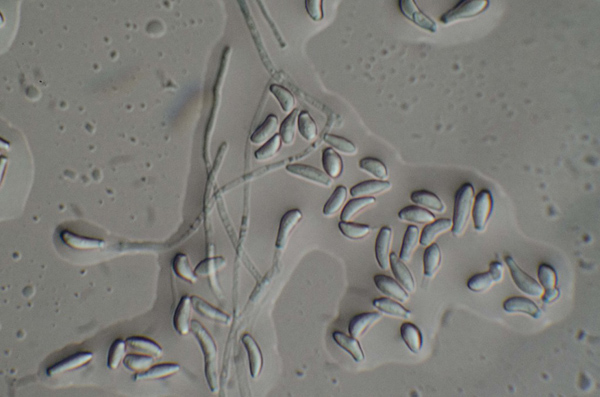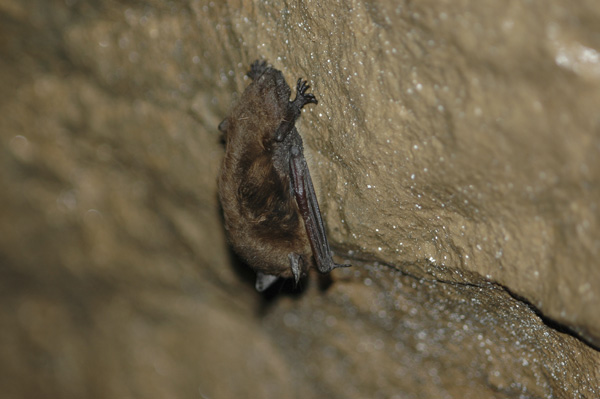Last week, 75 bats successfully treated for white-nose syndrome were released back into the wild in Missouri – rare good news in what has become one of the gloomiest wildlife stories in North America.
White-Nose Syndrome (WNS), caused by a fungus, has devastated bat populations in the eastern United States since it first appeared here almost ten years ago. An estimated 5.7 million bats have died, and conservationists have scrambled to find solutions.
The bats released last week all had White-Nose Syndrome, and were successfully treated with a common bacterium that releases Volatile Organic Compounds (VOC) with anti-fungal properties.
This hopeful story may be an important first step in managing WNS. And its scientific backstory is just as fascinating.
This innovative treatment’s development began not with bats, but with bananas.
That’s right: the bananas on your supermarket shelf play a surprising supporting role in bat conservation.

From Bananas to Bats
When researchers at Georgia State University began research on the common bacterium Rhodococcus rhodochrous they were not thinking about bats. They were not even thinking about fungi.
They were thinking about fruit. When bananas, peaches and other fruit are picked, the plants emit their own chemical signals. These begin the fruit’s ripening process.
When fruit has to be delivered thousands of miles to supermarkets – as is so often the case – it’s a race against time. The fruit can ripen and rot before it makes it to the store’s shelves.
Researchers were investigating the effectiveness of VOCs – emitted by the bacterium R. rhodochrous – in delaying ripening in fruit.

Researchers and graduate students began noticing another effect of these VOCs: fungus inhibition. The fruits exposed to the bacterium were not getting moldy.
Chris Cornelison was at the time a graduate student at Georgia State. He had been seeing the photos of dead bats piling up in caves, and a thought crossed his mind.
“I was standing there looking at a bucket of moldy bananas next to a bucket of bananas with no mold,” says Cornelison. “If the bacterium could be so effective on fungi on bananas, could it have similar effects on fungus on bats? It was one of those leaps of thought in science that maybe only a grad student could make.”
Cornelison, now a post-doctoral research associate at Georgia State, exposed petri dishes of the fungus that causes WNS (Pseudogymnoascus destructans) to the bacterium.
“The first exposure seemed too good to be true,” says Cornelison. “I had to test it five more times before I believed the results. It had dramatic effects on the fungus. It seemed like this could be a big step in managing white-nose syndrome.”
A Cooler Full of Bats
Other bat researchers and conservationists saw the potential for this bacterium and the potential to take action against a conservation issue that was frustratingly difficult to combat.
“When white-nose syndrome was first documented, we were scrambling to find information,” says Katie Gillies, director of the imperiled species program at Bat Conservation International (BCI). “We had to research the disease, understand how it works, how it spreads. But we also knew we had to take action.”
A number of partner organizations – including BCI, The Nature Conservancy and the U.S. Forest Service – worked with Georgia State researchers to test this bacterium as an initial tool to help manage WNS.
“In 2012, we tried our first crazy idea to build an artificial bat cave that could help us provide a hibernating place for bats that we could clean every year,” says Gina Hancock, state director for The Nature Conservancy in Tennessee. “Then when we formed a partnership with BCI, we kicked around what was the most promising work being done, and biocontrols came to the top of the list.”
Hancock notes that there was no public money being spent on this kind of research, so The Nature Conservancy and BCI sought proposals to accelerate the research.

At Georgia State, the laboratory results continued to be impressive. The next step was to test the bacterium on bats in a laboratory setting, and it worked. Bats suffering from WNS recovered.
Of course, the bacterium is essentially a biocontrol – a biological method of controlling an invasive species. As Cornelison notes, the use of biocontrol has a checkered history, one filled with unintended consequences.
The impacts of the bacterium on other native organisms would have to be fully vetted. But in the meantime, bats could be treated in a limited field setting.
First, bats suffering from various levels of WNS were collected in the wild. They are not actually treated with the bacterium; it’s the VOCs that have the anti-fungal properties.
The bats were placed in a mesh bags, then put in a large Yeti cooler containing plates of the bacterium. They stay there for 24 to 48 hours.
The treated bats were then placed in an enclosure in a wild cave, where they spent their hibernation. This spring, they were collected and tested for presence of WNS.
“We tested for their fungal load and compared that to the fungal load when we first captured them,” says plant pathologist Daniel Lindner, of the U.S. Forest Service’s Center for Forest Mycology Research. “The bats had no detectable signs of white-nose syndrome and could be released.”
Some of the bats had such severe wing damage from the fungus that they could not be released (these animals will serve as conservation ambassadors), but 75 were released at the Mark Twain Cave Complex in Hannibal, Missouri.
The bacterium does not cure WNS; it arrests the development of the fungus and inhibits its growth. But it is still a tremendous first step in finding ways to manage the disease.

From Lab to Cave
Could this bacterium be used to treat caves? Yes, but first more tests are needed. The treatment has to be tested for potential toxicity to other cave organisms, including native fungi. (This is why fungicides have not been used to fight WNS; they typically kill all fungi, not just the harmful species).
“We have to make sure it’s not going to upset the cave’s delicate ecology,” says Lindner.
Once those tests are completed, how do conservationists actually treat a wild cave? Researchers are considered a nebulizer that pumps the VOCs into the cave. “It’s a very sophisticated version of a commercial grade air freshener, like what a hotel might use,” says Lindner.
It could lead to treatment of caves, mines and bunkers – potentially creating safe havens for bats. “In this trial, we had to touch every single bat,” says Gillies. “The goal is to optimize this tool so that we can treat a large number of bats without touching them.”

Even then, this tool will not eliminate WNS.
“This is one tool but we will need many more to manage this disease,” says Lindner. “But tools like this could help us manage the disease. It buys time for bats to adapt to the disease and develop resistance. That could prevent extinctions and allow healthy bat populations to rebound.”
For several years, talking to bat conservationists was an exercise in despair, in helplessness. WNS is still a major problem, and one that will continue to require innovation and research on a number of fronts.
But the sight of bats – bats that would have died of the disease – flying through the woods after successful treatment suggests a new chapter in this story. A new hope. “We are finally at the point where we can intervene on white-nose syndrome,” says Gillies. “It is not a silver bullet. We need more tools. But it is a first step. A huge first step.”




Keep up the research. Try to inform the public of the importance of bats…..( They eat massive amounts of mosquitos ) Which could lead to fewer cases of human diseases…ie Encephalitis…….Rabies and the like!! If people thought it would help them, They might be willing to donate Funds!!!
OMG such a great prospect for our bats. Fingers (and toes) crossed that we can start to put an end to WNS.
YYYAAAAAAYYYY! You people are AWESOME! Thank you for helping bats, one of our most un-appreciated yet VERY important mammals. I shudder to think of the load of insects we’d all be fighting and suffering from if it weren’t for our microchipterian, mosquito slurping little buddies.
Sounds like excellent news and conforting ones as well.
Spectacular news! Congratulations to each and all the bright, inquisitive, determined minds involved, especially that extrapolating grad student! Particularly admirable is the deliberate caution being exercised to avoid collateral damage; the lessons of history were not lost on this team! A tip of the hat to Georgia State!
I’ve had Little Brown Bats every year since 2008 in my bat house in the Blue Ridge Mountains, Virginia–except 2014 & 2015, when they did not return. I was afraid they’d died of the white nose syndrome. But this past summer of 2016 they were back! Not as many, but I’m so happy to see them again.
I found this article very interesting! I am very glad that their might be a cure for WNS!
batgirlblog.com
Wow! Great!
I came across this article while looking for woods with certain tannins in hopes to build bat boxes that contain some ani-fungal agents to help them at least rest in a safe place and I don’t know if they over winter inside the bat boxes or not, but if so then a safe place to over winter.
Do you think Bat boxes could be built to contain these VOC’s in hopes that they will prevent at least the fungus from thriving where they sleep in a controlled way?
Please reply if you can, I would try to produce bat boxes that could do that if it were viable. I am from The Laurentians north of Montreal, where we always took great pleasure in watching the bats at night, come out like our personal hero’s to deplete the mosquito population. In recent years we haven’t seen a single bat all summer.
Hope for an effective treatment of a devastating problem here. Now how can the fruit bats of Australia be trained to return to caves? Is it presumptive that their ancestors were cave dwellers?
This is a huge relief to hear about.
Such good news-thank you Geogia State University and Chris Cornelison! Hundreds of thousands, perhaps millions of bats, will be saved by your work. Thank you, thank you. Bats are marvelous creatures. I hope to put bat houses in the large ( almost an acre) yard of the house I bought and hope to be in soon!!!
You may have missed the scientific discovery that caves sprayed with a weak solution of vinegar killed the bacteria. This may be added to the possible treatmeants you have discovered. Peace.
Congratulations everyone……… ! Staving off this terrifying scenario is massive. My Hats off to you all… My God crack the seal on a bottle and celebrate. ! These little animals are an integral part of the ecosystem and it is crucial to hold on the numbers still left and maintain these numbers as research continues on a more permanent cure.